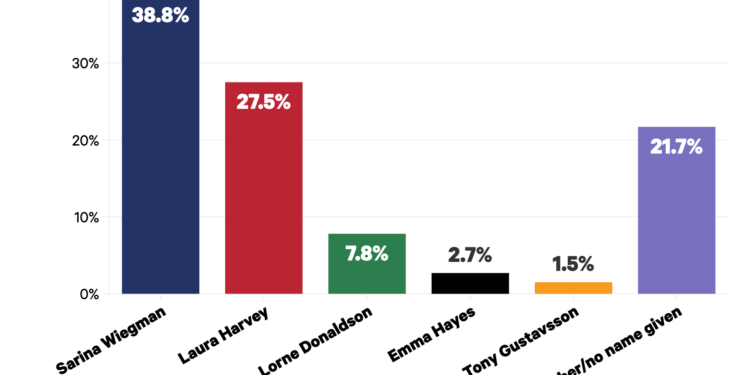It’s a nervy time for USWNT supporters. Vlatko Andonovski is out as head coach, Kate Markgraf is out as general manager — and there’s not much else actually known about the strategic plan for the women’s program under the guidance of U.S. Soccer technical director Matt Crocker at this time.
Last week, we asked for your thoughts and opinions around the team following their round of 16 exit in the World Cup and your level of concern about the NWSL, youth national teams and more. Over 2,000 of you voted, and plenty of you had even more to say when we asked for your thoughts in your words.
Here are the results of our USWNT survey.
So who’s the next USWNT head coach? We’re probably not going to know the answer for at least a month or two. Unfortunately, the leading choice for most of you — Sarina Wiegman — is very unlikely to depart her role with the Lionesses. And despite the loss in the final, her name is being linked to plenty of roles.
“I’m staying out of it,” Wiegman said last week. “I’ve heard it (from the press officer) but no, I’m with England and I’m really happy with England, and I have a contract until 2025.”
Laura Harvey, who has U.S. Soccer experience and just signed a contract extension with OL Reign, earned 27.5% of the votes, and 21.7% of those who took the survey either left this one blank or wrote in a name. Write-ins obviously didn’t pick up a ton of consensus, but San Diego Wave FC head coach Casey Stoney led this category with 11 votes, followed by Nigeria WNT manager Randy Waldrum with seven.
Some of you also used the write-in to provide more specific plans, such as Laura Harvey coaching through the Olympics, then running a coaching search. It’s an interesting premise – figure out a short-term solution with a coach that most players know, considering the tight timeline until the next major tournament, then determine if it could also be a longer-term solution through the 2027 World Cup or if a fresh search is necessary. Is a plan like that fair to Harvey, who’d have to give up the Reign job for a far less secure role? Ultimately, a decision like that is up to her.

Our next question became a bit of a moot point by the time the survey went up, with general manager Kate Markgraf and U.S. Soccer announcing that she’ll depart her role at the end of the month. It’s clear from the survey results that most of you won’t mind that decision, with 73.8% of the respondents (1,945 for this question) voting that she should not remain as the head of the women’s national team program.
Markgraf’s departure is just another piece of the turnover across the federation’s sporting side. Crocker was hired earlier this year, following the departure of Earnie Stewart, but USMNT general manager Brian McBride also left the program. It should allow Crocker to design the sporting side in his vision, but one problem that this survey might reveal is that many of you have some questions about his ability to lead.

Now, we didn’t give folks the opportunity to write-in why that might be, but considering the number of strays USMNT head coach Gregg Berhalter picked up in the final write-in question on the survey, there’s definitely some influence from the end result of the coaching search on the men’s side that appears to be carrying over.
Next up: the biggest problem for the USWNT right now — and while this was a write-in, there were three clear threads that you all agreed on: development, coaching and tactics. Many of you simply picked one of those three options and wrote it in as a single word. Injuries also got plenty of nods, but the big three came through time and time again, no matter if it was a single word or a whole paragraph of thoughts.
Many of you also focused on the idea of the team’s identity. Here’s a sample of some comments from this question:
“No team identity in how they play. No structure, no system.”
“Playing style vs. identity. Who are they trying to be on the field vs. who they truly are.”
“They’re rudderless.”
And there were the big-picture thinkers, too. One person wrote, “U.S. Soccer/infrastructure. It isn’t a talent issue.” Another: “Fractured youth landscape.”
But maybe this one sums it up best: “Oof. I think the biggest problem is that there isn’t one thing.”
When it comes to leadership voices you want in the mix, regardless of roles, of the 945 write-ins we received, the ‘99ers and other former players absolutely led the way. We’ve seen their influence start to grow within the NWSL, especially across the ownership ranks of teams like Angel City FC and Bay FC, but it’s clear that there’s some real trust there on their voices at every level of the game. Brandi Chastain was the most common name across the board, but Julie Foudy and Mia Hamm also got numerous name-checks. Of the more recent generation of players, everyone from Megan Rapinoe, Alex Morgan, Becky Sauerbrunn, Tobin Heath and so on earned at least 25+ write-ins, but Carli Lloyd proved another popular pick. Lloyd had a number of people specifically saying she should not be a former player in the mix, however, unlike most others.
In terms of coaches, Laura Harvey got the most write-ins here with over 70, followed by former USWNT head coach Jill Ellis with over 60.
Back to Carli Lloyd for a moment. Her comments on the USWNT turned out to be one of the biggest storylines of the tournament, for better or worse, and the team pushed back on them during the tournament itself. Over 2,000 of you voted on this one, and it was a close vote — but 55.3% decided that they did not agree with her assessment.

On the matter of U.S. players needing to play their club soccer abroad to better challenge themselves, it seems like the public sentiment is turning here — a majority of you think that they should be looking overseas. USWNT captain Lindsey Horan is staying in Lyon, and midfielder/forward Catarina Macario made the move to Chelsea, alongside forward Mia Fishel with her transfer from Tigres.
The competition for top talent is only going to get more heated, but in reality, this won’t be a one-size-fits-all approach for the U.S. talent pool.

Onto the NWSL — and yes, there’s some concern here about the league following this World Cup. It’s more than just the USWNT exiting in the round of 16 that should be ringing some alarm bells: other NWSL-heavy national teams like Brazil and Canada also underperformed in this tournament. Germany crashing out in the group stage helps prove that it’s not just about a single league or a single root cause, but 69.1% of you think that the NWSL should be considering its global standing moving forward.

And if the NWSL should be worried, there’s even more concern about the state of the youth national teams.
As a reminder, here’s what I wrote about the U-17s and the U-20s following the 0-0 draw between the USWNT and Portugal in the group stage:
The last time the U-20s won their World Cup was in 2012. Over the next three tournaments, their final placement got worse with each successive tournament: fourth place in Papua New Guinea in 2016 (losing to Japan), ninth in France 2018, 11th in Costa Rica 2022. The last two times, the U.S. failed to advance from their group.
It’s even rougher for the U-17s. Their best performance in the World Cup was in the inaugural one for the age group, in 2008 — held in New Zealand. The U-17s finished second there, but failed to advance from their group in 2016 and 2018 (finishing 10th and 13th place, respectively), and in the most recent U-17 World Cup, they lost to Nigeria in the quarterfinal for a sixth place finish.

Finally, the big one: has the U.S. fallen behind other nations when it comes to the performance of the women’s program? A slim majority voted yes.

Is it as clear-cut as a yes/no question on a survey? No, probably not. But this is a clear reflection of some of the nervousness surrounding the USWNT right now, whether that’s the performance of the team, the coaching, the tactics, or the pathway of development. As we’ve been saying for a while, there’s a lot on the table when it comes to fallout and fixes, and with England and Spain making the final, there are some easy comparisons to be made.
And finally, we let you have the mic for any final thoughts, and most of you used it as a chance to push back on some of the yes/no nature of the questions, especially the last one.
“The rest of the world is catching up AND the U.S. has fallen behind — it can be two things,” read one answer.
On the same theme: “The rest of the world catching up is a good thing for the sport as a whole, and to me, that is much more important than the USWNT’s failure.”
Another pushed back that this should even be considered a failure on that level: “USWNT dominated the world for 20 years. That’s DONE. Quit obsessing about it! This is NOT a failure. The women’s game is now just like the men’s — anyone can win. Good! This is sport.”
There were a number of comments here about youth development, particularly the pay-to-play model. “The system needs more openness,” one person wrote.
And some expressed frustrations with the lack of communication at this time from the federation. For instance: “Tired of the federation being invisible when the going gets tough… Crocker and (Cindy) Parlow Cone (U.S. Soccer president) should be doing a media tour right now talking about the ‘next stage’ for both the men’s and women’s program. Instead crickets.”
As someone who wrote about the vacuum of information, timelines and process right now, I agree.
And some of you left us with new questions to ponder. “The performances from 2011-2019 were the (outstanding) aberration here. The USWNT performed as expected this World Cup, and a loss in penalties is heartbreakingly normal for elite teams. The real question is: what took so long for the rest of the world (i.e. England, Spain), whose soccer institutions for men far out-date ours, to catch up to a country who mainstreamed soccer in the 1990s?”
Over 2,000 votes later, we’re not any closer to knowing most of the true answers to these big-picture questions around the USWNT and the program as a whole, but the survey was revealing in showing how supporters and fans are thinking about the team in this moment, a few weeks out from the loss to Sweden.
(Photo: Joe Prior/Visionhaus via Getty Images)










